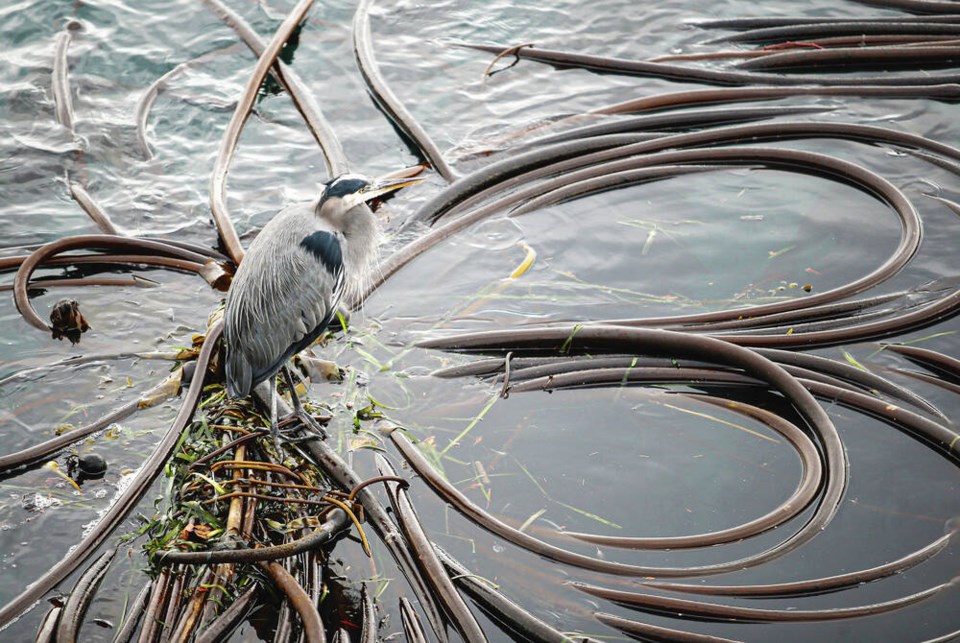When amateur fossil collector and Burke Museum of Natural History and Culture research associate James Goedert broke open some stones he’d found on an Olympic Peninsula beach, what he saw extended the known presence of kelp along the northeast Pacific coast by 18 million years and has provided insight into kelp ecosystems of the time.
Inside the rocks were the fossils of a kelp holdfast, as well as of bivalves, a barnacle, a snail and a tiny plankton-like animal dating back 32 million years.
But the researchers who studied the fossils say those early kelp forests were likely less complex that those that came later or exist today.
They say that, according to chemistry-derived estimates of prehistoric water temperatures, the global cooling trend that led to the ice ages 2.5 million years ago may have facilitated the development of complex, biodiverse kelp forests around 14 million years ago.
Fossil evidence from that later time shows that kelp forests supported clams, mussels and an abundance of similar bivalves, as well birds and sea mammals, some of which have since become extinct.
Today, kelp forests are among the planet’s most diverse ecosystems. They are home to hundreds — even thousands — of species of invertebrates, fishes and other algae, as well as seals, sea lions, sea otters, whales and birds.
They feed and shelter economically and culturally important species, including herring, black rockfish, Pacific cod, young salmon and abalone. They remove excess nitrogen and phosphorous from the water. They reduce coastal erosion. They absorb carbon dioxide from the atmosphere. They may even dampen the noise we raucous humans fill the ocean with.
But since 1950, 40 to 60 per cent of the world’s kelp forests have either suffered damage or disappeared.
Kelp thrives in cold water. When sea-surface temperatures reach 18-20 C, kelp begins to die.
After the Blob, the 2013-2016 marine heat wave that raised the temperature of the northeast Pacific Ocean by an additional 2.5° C, researchers found that 40 per cent of kelp beds in Barkley Sound had disappeared. Most kelp there disappeared from warmer inshore waters, where surface temperatures reached 22 C.
Smaller, shorter-lived marine heat waves have since occurred in the region, including one in 2019-2020.
By encouraging the spread of sea star wasting disease, marine heat waves also favour kelp-munching sea urchins, which can clearcut kelp forests. During the Blob, the disease nearly wiped out sunflower stars along parts of B.C.’s coast. Sea urchin populations exploded and more kelp forests fell.
If another voracious sea urchin predator hadn’t been hunted to regional extinction 100 years ago, the disease might not have affected kelp forests to such a degree. Although sea otters have spread along the coast since they were reintroduced to Vancouver Island’s northwest coast in the 1970s, they have not yet returned to all areas where they once helped protect kelp forests.
Healthy, diverse and whole ecosystems usually include backup species that keep the overall system balanced. When you remove one of those components — e.g., sea otters — another — sea stars — may be able to compensate and fill the newly empty niche. But when you remove that second component, the system becomes apt to break down.
In addition, a new threat that reduces kelp reproduction thrives in warmer water. First Nations along the central coast have spotted tiny kelp-encrusting crustaceans called bryozoans in a growing number of kelp beds.
Each impact reduces kelp-forest health and resilience. The ecosystems we’re producing through overhunting, climate change and so on aren’t the simple-by-nature systems of 32 million years ago. The 21st-century kelp forest ecosystems we’re creating are simpler than they should be, therefore more vulnerable to change and less resilient.
To help and support the province’s underwater gardens, researchers and citizen scientists are now tracking B.C.’s remaining kelp forests to determine the past, present and future of kelp resilience on the coast.
They’re using satellite imagery to pinpoint where kelp beds have survived and where they might decline or disappear, as well as associated ocean changes, to better understand the conditions that foster resilience and to identify kelp with genetic resistance to stressors. They’re also looking into ways to plant and foster new kelp forests.
In a time of global change, they’re taking steps to repair and reduce damage to these important underwater forests and to keep them healthy and productive for the benefit of us all.
>>> To comment on this article, write a letter to the editor: [email protected]



